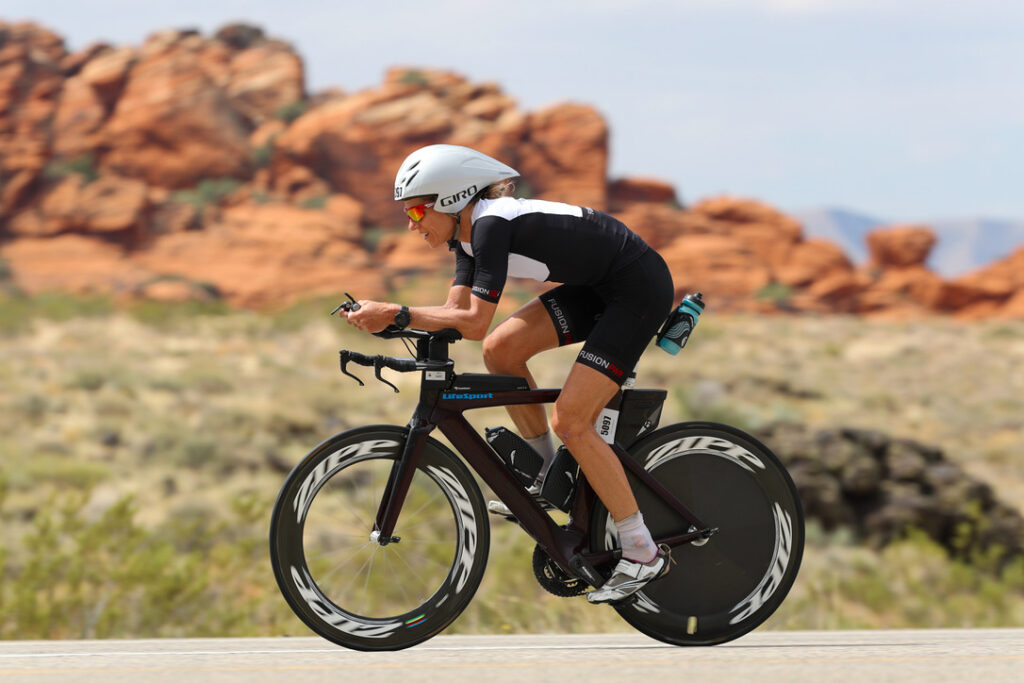Over the years of coaching I’ve heard this question voiced often as we approach the start line of triathlons with a lot of climbing and descending on the bike course. “Should I ride a triathlon bike or a road bike with clip on aero bars?” The truth is the majority of tri bikes climb almost as well as road bikes and the slight weight penalty ascending is more than made up for with the aerodynamic savings on the flats and descents. Just take a read through “Faster – Demystifying the Science of Triathlon Speed,” by Jim Gourley to see calculations and examples. The consensus is that aerodynamics trump weight in all but the steepest events.
There is a caveat, however. After observing many riders at camps and during training, I’d add the disclaimer that athletes have to take ownership of the aerodynamic advantage tri bikes possess to obtain the best effect.
To be specific, athletes must ride confidently in the aerobars as much as possible. This is fairly simple when it comes to the flatter or gradual downhill portions of the ride. When it comes to the steeper or more technical segments, however, where bike speeds can reach up to 80kph – and where it is critical to be aero as drag increases significantly as velocity increases – we often see athletes riding with their hands on the base bar near the brakes. This position slows things down considerably. Riding on the hoods or flats is a double whammy against the rider who is close to time cut-offs. Sitting up significantly increases the amount of aerodynamic drag and also lowers the rider’s safety at higher speeds.
With these considerations, it would be better to be on regular drop bars for a number of reasons.
1. It is more aerodynamic as the body is lower.
2. The rider has better control since his center of gravity is lower and there is more force on the front wheel increasing tire contact patch, thus traction. The rider’s hands are also closer to the brake levers and s/he is able to feather the brakes more effectively. By having the hands in this lower position, the rider has much better control over the bike, especially when descending. Check out any of the high-speed cycling descending videos on YouTube for additional illustration.
Schedule time in the final training block to practice riding at higher speeds, either in the aerobars or in the drops. Aim to build up your comfort level and improve your bike handling skills. Two areas to work on in particular are vision and braking.
Vision. All driving schools teach you where to look. The further you can look down the road, the more prepared you are for what is coming at you. By only looking just ahead of the bike, obstacles appear too fast for you to react. But scanning the road at close to the limit of vison and looking through corners will warn of any upcoming hazards. Similarly, try to avoid target fixation. Staring at an object while riding is the easiest way to hit it. Practice looking at where you want to go, not where you don’t.
Braking. Bicycle tires are narrow and have a very small contact patch. With a limited traction circle, they only like to do one thing at a time; either braking or turning. The goal when travelling or descending at speed is to slow down before the bike and rider arrive at the corner. Once speed has been scrubbed off, start the corner entry wide and slowly tighten the radius so that you exit the corner as straight and upright as possible.
By practicing these bike handling techniques in the weeks and months leading up to your hilly race, you will be better prepared to take advantage of the terrain, putting time into your competitors and giving yourself a better cushion to make cut off times.
LifeSport coach Dan Smith has coached beginner and top age group athletes to success at 70.3 and IRONMAN distance races for over 15 years. He is an IRONMAN Age Group champion, and 3x Kona and XTERRA World Championship finisher.
Beginner and experienced triathletes looking to start or improve their performances are invited to join the LifeSport team. Visit us on the web at www.LifeSportCoaching.comor email LifeSport Coaching at coach@LifeSportCoaching.com.
